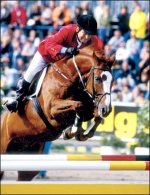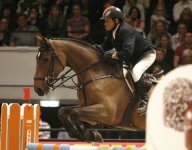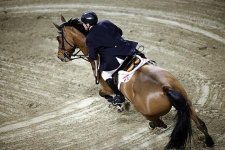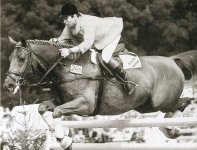♘امیرحسین♞
♘ مدیریت انجمن اسب ایران ♞
He won two world cups, ended fourth at the Atlanta Olympics and landed 120 podia in a decade. There was only one thing top showjumper E.T. couldn't do — father foals. But now a French laboratory is creating a clone of the 17-year-old gelding with a view to putting it to stud. E.T-Stallion will be a genetically identical copy of E.T. and, when he grows up, he will be able to cover mares.
Austrian rider Hugo Simon, who rides E.T., announced last week that he agreed to have his horse cloned. "I wanted to save its genes," he told the press at the Vienna Horse Jumping Festival. "The experiment was only carried out for breeding reasons. When young E.T. shall see the light of day in summer 2006, it will be a dream come true for me."
Simon was approached by French genetic laboratory Cryozootech more than a year ago. Cryozootech, which has already cloned endurance champion Pieraz, was storing cells from top sporthorses. E.T. caught their eye because of his hugely successful career and record earnings.
"I wanted a horse the quality of which was unquestionable and that was gelded," Cryozootech CEO Eric Palmer explains. "I came too late for Milton, but E.T. has the absolute record of earnings in show jumping, won three times the WBFSH ranking and twice the world cup. He also has excellent bloodlines. His father and his grandfather have been elected at least once "Stallion of the year" in Hannover. So, I think nobody can discuss the fact that castrating such a quality horse was a mistake and that restoring his capacity to transmit his genes is a good thing."
Simon was initially reluctant to have his horse cloned, but Palmer persuaded him when he explained that the cloning process would only create a stallion with the same genetic patrimony as E.T., rather than give birth to a second jumper.
"Hugo was first surprised and said that "there is only one E.T.," Palmer recalls. "But when I explained that I agreed on the fact that the clone was not a second E.T., but that as a stallion he would give exactly the same genes, he said "of course I would love to have offspring from E.T.". That what will be possible with E.T-Stallion."
Palmer then took some cells from the area between E.T.'s front legs, which he cultivated, froze and preserved in liquid nitrogen. "The storage of such a treasure is done in several places for safety," says Palmer.
The Cryozootech team then prepared the cells for injection into an oocyte—the unfertilised egg of a mare—then removed the oocyte's nucleus and replaced it with the nucleus of E.T.'s cells. After cultivating what Palmer calls a "reconstructed embryo" for a week, the team implanted it in a recipient mare, which will carry the pregnancy to term.
"Of course it seems easy when explained like this, but each step is difficult and has a low efficiency," says Palmer. "The overall efficiency takes several hundreds of ova to get one foal. This is why this is a technique only for exceptional horses."
E.T-Stallion will be born next summer, and this announcement has reopened the debate over sport horse cloning. Earlier this year, the British government banned commercial cloning of sports horses on the grounds that it is unclear how much a horse's performance depends on its genetic makeup and that in any case cloning is an inefficient reproduction method that can result in abnormalities.
Professor Twink Allen of Newmarket's Equine Fertility Unit, who is at the forefront of this kind of experiment, decided to appeal against this decision and claimed that, while Britain dithered, other countries were already working on cloning to overcome the problem of reproducing sport horse geldings. Now that France's Cryozootech has cloned Pieraz and is well on the way to cloning E.T., his fears appear well founded.
Speaking to Horse & Hound Online, earlier in the year, Allen argued that horse cloning has a low incidence of abnormality compared to cattle and sheep. Cryozootech's Palmer agrees and believes that overall the procedure has a minimal impact on welfare. "The oocytes [we use in cloning] come from ovaries that we collect at slaughter houses and that would be put to waste otherwise. No suffering of donor animals come from the procedure and these animals were slaughtered anyway," he says. "The transfer is the same as the routine embryo transfer and you know that the key of success of such embryo transfers is: no stress to the embryo nor to the recipient. There is an increased embryo loss during early pregnancy, but I cannot see any sign of suffering in mares during early embryo loss. There are some later abortions that do not differ from the abortions we see in normal breeding except a higher incidence.
"Now we know three cloned mules and one cloned horse from 2003 (they are two and a half years old and they are in good health). We have produced this spring the first two clones of champions—Pieraz Cryozootech-Stallion, clone of Pieraz, a double world champion of endurance races, and Paris-Texas, the clone of Quidamde Revel, the top stallion of show jumping—and they are now eight months old and in perfect health."
But the question remains whether the genes of a champion showjumper, endurance or dressage horse will actually produce equally talented offspring. After all, training plays a considerable part in the success of a sporthorse.
"I know that genetics is approximately responsible for 1/3 of the performance," says Palmer "In fact genetics is only a "potential" and everything around it (the "environment" which starts in the mother's uterus, the lactation, the accidents, the breaking and dressage, and finally the rider) gives a possibility for this potential to be expressed. In consequence, you cannot assert that the clone of E.T. will perform exactly the same way [as E.T. did]. However, you can assert that he has in his genes exactly the same potential as E.T. and that he will transmit it exactly the same way as if E.T. was a stallion himself."
And, he adds, "there is no champion with no potential!"
It remains to be seen whether the international sporting community will accept cloned horses and their foals. So far, there are no specific rules on the matter. "We don't have any rules on this matter because it is regarding breeding and the FEI doesn't interfere on any breeding issues," says an FEI spokeswoman. "And also those horses, if they survive, won't be competing for years so the FEI doesn't have any policy on the issue."
Palmer, however, believes that there should be a clear framework of rules to allow cloned horses and their offspring to have a sporting future. "I cannot see how there can be an international ban [on cloned horses]," he says. "International competitions do not need registered horses and a ban would just cause unofficial clones to be produced. This is exactly what we want to avoid by making our operation in front of the public. Make reasonable rules and transparency is certainly the best attitude."
Austrian rider Hugo Simon, who rides E.T., announced last week that he agreed to have his horse cloned. "I wanted to save its genes," he told the press at the Vienna Horse Jumping Festival. "The experiment was only carried out for breeding reasons. When young E.T. shall see the light of day in summer 2006, it will be a dream come true for me."
Simon was approached by French genetic laboratory Cryozootech more than a year ago. Cryozootech, which has already cloned endurance champion Pieraz, was storing cells from top sporthorses. E.T. caught their eye because of his hugely successful career and record earnings.
"I wanted a horse the quality of which was unquestionable and that was gelded," Cryozootech CEO Eric Palmer explains. "I came too late for Milton, but E.T. has the absolute record of earnings in show jumping, won three times the WBFSH ranking and twice the world cup. He also has excellent bloodlines. His father and his grandfather have been elected at least once "Stallion of the year" in Hannover. So, I think nobody can discuss the fact that castrating such a quality horse was a mistake and that restoring his capacity to transmit his genes is a good thing."
Simon was initially reluctant to have his horse cloned, but Palmer persuaded him when he explained that the cloning process would only create a stallion with the same genetic patrimony as E.T., rather than give birth to a second jumper.
"Hugo was first surprised and said that "there is only one E.T.," Palmer recalls. "But when I explained that I agreed on the fact that the clone was not a second E.T., but that as a stallion he would give exactly the same genes, he said "of course I would love to have offspring from E.T.". That what will be possible with E.T-Stallion."
Palmer then took some cells from the area between E.T.'s front legs, which he cultivated, froze and preserved in liquid nitrogen. "The storage of such a treasure is done in several places for safety," says Palmer.
The Cryozootech team then prepared the cells for injection into an oocyte—the unfertilised egg of a mare—then removed the oocyte's nucleus and replaced it with the nucleus of E.T.'s cells. After cultivating what Palmer calls a "reconstructed embryo" for a week, the team implanted it in a recipient mare, which will carry the pregnancy to term.
"Of course it seems easy when explained like this, but each step is difficult and has a low efficiency," says Palmer. "The overall efficiency takes several hundreds of ova to get one foal. This is why this is a technique only for exceptional horses."
E.T-Stallion will be born next summer, and this announcement has reopened the debate over sport horse cloning. Earlier this year, the British government banned commercial cloning of sports horses on the grounds that it is unclear how much a horse's performance depends on its genetic makeup and that in any case cloning is an inefficient reproduction method that can result in abnormalities.
Professor Twink Allen of Newmarket's Equine Fertility Unit, who is at the forefront of this kind of experiment, decided to appeal against this decision and claimed that, while Britain dithered, other countries were already working on cloning to overcome the problem of reproducing sport horse geldings. Now that France's Cryozootech has cloned Pieraz and is well on the way to cloning E.T., his fears appear well founded.
Speaking to Horse & Hound Online, earlier in the year, Allen argued that horse cloning has a low incidence of abnormality compared to cattle and sheep. Cryozootech's Palmer agrees and believes that overall the procedure has a minimal impact on welfare. "The oocytes [we use in cloning] come from ovaries that we collect at slaughter houses and that would be put to waste otherwise. No suffering of donor animals come from the procedure and these animals were slaughtered anyway," he says. "The transfer is the same as the routine embryo transfer and you know that the key of success of such embryo transfers is: no stress to the embryo nor to the recipient. There is an increased embryo loss during early pregnancy, but I cannot see any sign of suffering in mares during early embryo loss. There are some later abortions that do not differ from the abortions we see in normal breeding except a higher incidence.
"Now we know three cloned mules and one cloned horse from 2003 (they are two and a half years old and they are in good health). We have produced this spring the first two clones of champions—Pieraz Cryozootech-Stallion, clone of Pieraz, a double world champion of endurance races, and Paris-Texas, the clone of Quidamde Revel, the top stallion of show jumping—and they are now eight months old and in perfect health."
But the question remains whether the genes of a champion showjumper, endurance or dressage horse will actually produce equally talented offspring. After all, training plays a considerable part in the success of a sporthorse.
"I know that genetics is approximately responsible for 1/3 of the performance," says Palmer "In fact genetics is only a "potential" and everything around it (the "environment" which starts in the mother's uterus, the lactation, the accidents, the breaking and dressage, and finally the rider) gives a possibility for this potential to be expressed. In consequence, you cannot assert that the clone of E.T. will perform exactly the same way [as E.T. did]. However, you can assert that he has in his genes exactly the same potential as E.T. and that he will transmit it exactly the same way as if E.T. was a stallion himself."
And, he adds, "there is no champion with no potential!"
It remains to be seen whether the international sporting community will accept cloned horses and their foals. So far, there are no specific rules on the matter. "We don't have any rules on this matter because it is regarding breeding and the FEI doesn't interfere on any breeding issues," says an FEI spokeswoman. "And also those horses, if they survive, won't be competing for years so the FEI doesn't have any policy on the issue."
Palmer, however, believes that there should be a clear framework of rules to allow cloned horses and their offspring to have a sporting future. "I cannot see how there can be an international ban [on cloned horses]," he says. "International competitions do not need registered horses and a ban would just cause unofficial clones to be produced. This is exactly what we want to avoid by making our operation in front of the public. Make reasonable rules and transparency is certainly the best attitude."







